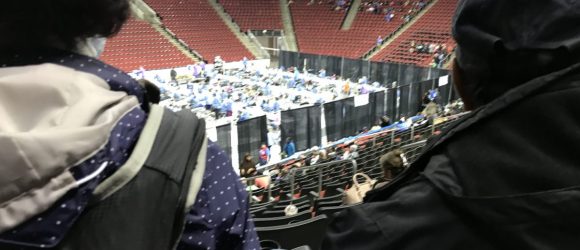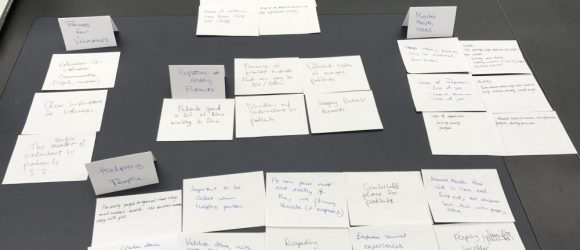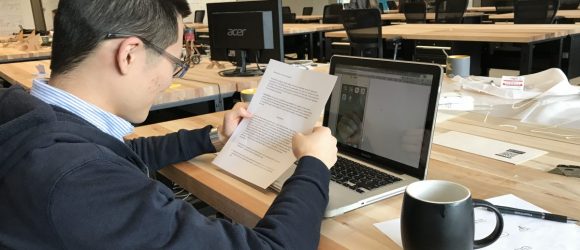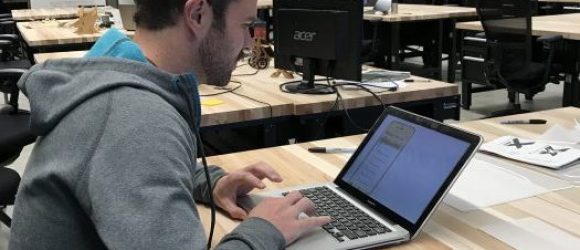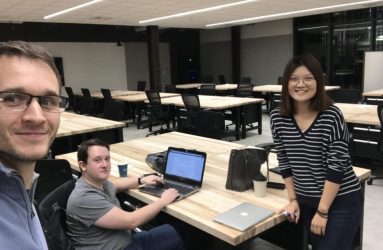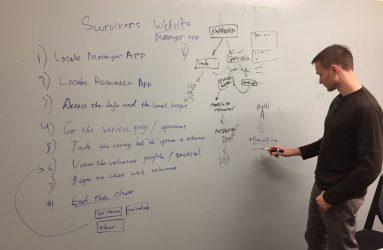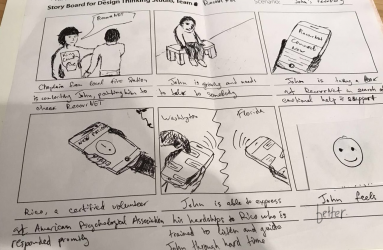Team 14, RecovrNet
Project Description & Design Question:
Description. During Design Thinking Studio course at University of Washington my team focused on a problem of providing psychological support and mental health services in disaster areas potentially lacking cellular, landline, and internet connectivity.
Design Question. After multiple iterations of refining the design question addressing problem at hand, we phrased it as follows: “How can we raise awareness for and provide natural disaster survivors with private access to triaged mental health aid, emotional support, help with resource location, access to virtual support groups, and/or local communication board after basic survival needs are met, regardless of problems with access to local communication networks and mental health professionals?“
Solution:
My Role in the project:
Our team was working well together and everyone did a fair amount of work in order to move through each of the project phases. My responsibilities that I chose to carry out were:
- Facilitated meetings
- Team building
- Performed extracurricular research to gain deeper understanding of the problem, including set up of an interview with a local firefighter
- Researched technical solutions and emerging solutions to problems in the disaster recovery problem space
Motivation:
The possible project topics were:
- Transportation/ Commuting
- Disaster Preparedness and Resilience
- Nutritional Health
Personally I was excited about the topic of re-establishing communication during disaster recovery because I live in a potential disaster area and felt like my technical expertise could help other people establish communication channels after disasters faster.
Timeline of work performed:
We worked on this project for a total of 11 weeks.
Below you can see complete timeline of main deliverables and short description for each one (click on the arrows to navigate):
Design Thinking Process Overview
We went through the following phases of design thinking process:
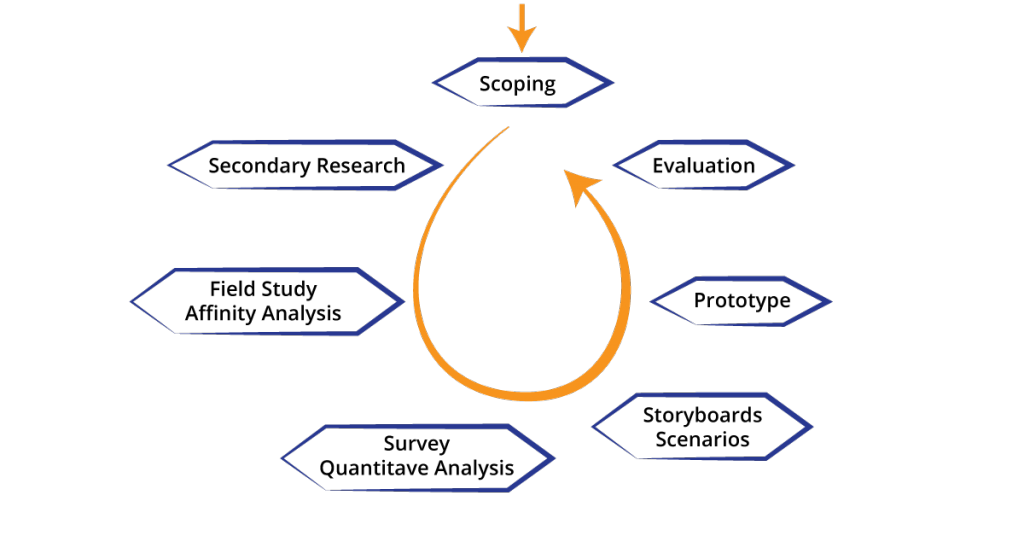
Design Thinking Process
During each phase of this process we gained deeper understanding of the user needs and of requirements for our solution.
Secondary Research:
My team performed extensive secondary research in order to understand the scope of the problem and what is currently done to resolve it. We utilized a variety of sources to find existing research into the topic of disaster resilience and recovery:
- UW Library resources (http://www.lib.washington.edu/)
- Local and international newspapers and news websites
- King County emergency preparedness plans
- FEMA website (FEMA.gov)
- American Psychological Association (APA.org)
Through this research, my team and I found out a variety of facts, specifically:
- What attributes do the volunteers need to possess to be able to provide effective mental health help
- How many people are prone to develop PSTD after disasters
- Number of people that could be affected by a major Earthquake in Seattle area
- Which organizations are currently involved in providing mental health assistance after disasters
Here is the list of the sources we used in our research:
COHEN RE. Mental health services for victims of disasters. World Psychiatry. 2002;1(3):149-152.
Rob Butler, King County Office Of Emergency Management Disaster And Emergency Preparedness Survey Research – 2004.
Guha-Sapir D, Hoyois Ph., Below. R. Annual Disaster Statistical Review 2015: The Numbers and Trends. Brussels: CRED; 2016.
“Washington’s 30-year earthquake drill for the ‘Big One’: Order studies. Ignore them. Repeat.” Jan 17, 2017
Mental health in emergencies, WHO http://www.who.int/mediacentre/factsheets/fs383/en
Disaster Resource Network – http://www.apa.org/practice/programs/drn/index.aspx
Personal reflection:
During the secondary research phase I was able to find data and statistics about local disaster preparedness resources which informed us in the later phases.
Most of the information was easy to access via UW library website, but in some cases it was buried pretty deep in digital archives and low-SEO websites.
For example I was able to find a few reports from the King County Office of Emergency Management that were not obvious but revealed some crucial statistics about disaster preparedness in Seattle area.
Another set of non-obvious sources was APA website and FEMA surveys and reports. Since our problem is dealing with psychological issues, the data I found on APA website was highly relevant.
I think my approach to finding secondary research provided the team with enough information to work with, but if I were to do this again, I would probably go to the library in person and experience the magic of diving into research first-hand. The search for information online is quite monotonous and not as interactive as I’d like it to be.
Primary Research:
For our primary research we have conducted a few studies that further shaped how our solution would work: observation studies, surveys and an interview. After conducting three different types of research we have worked together as a team to produce affinity analysis over the gathered data and came up with a few dozen key insights guiding our research.
Below you can find the description of each research method performed and a couple photos from the studies:
Observation Study
For my observation study, I wanted to attend a public clinic for low income persons because in some ways it closely resembles disaster area shelter experience. I tried to politely ask the event organizers if I could just go in as a student and observe the event but was denied entry and explained that I’d have to schedule that a few months in advance. I had to get a little creative and enrolled as a patient instead, which gave me access to all areas that I needed to observe for the study. I even had to take a blood sugar test to be taken through all steps of the process.
The clinic was held at Seattle Center arena and hosted about 1500 volunteers that took care of approximately 1000 people a day. The patients at the clinic were of diverse races, ages and with a wide variety of medical conditions that needed attention. From dental work, vision checkups, to mental health and X-Rays, a range of services was offered in a structured manner. The main insights derived from this study were focused around logistics, volunteer participation, information gathering and transfer within context of a carefully planned “field hospital”.
After analyzing the findings of this and the other field study performed by other students in my group, we were well-prepared to create a survey in order to get more insights about our problem.
I was surprised how many insights we were able to gather from observing people for just a short period of time.
Survey
During the survey I learned that people really wanted to participate and were eager to take the survey even though no reward was promised in any way. We conducted a survey of 21 respondents that reside in urban areas in or around Seattle. Extracting meaningful insights from such small sample size was challenging, but we were able to validate or falsify a few key assumptions and got concrete ideas for the next steps. Some of the assumptions we validated or discovered:
- People might use text based interface for psychological help, but only if the person on the other end is a professional, with verified credentials and well visible bio (validated)
- After disaster, people would look for network connectivity in public places such as fire stations, police stations, libraries, city halls (discovered)
I learned how to prepare a survey and the steps that are leading up to it and the analysis that follows the survey. In retrospect, I think we could’ve started thinking about survey questions much earlier or at least think about which groups we needed to target and how to craft questions for the survey. Seeing examples of survey questions could also help a lot next time.
Interview
I wanted to understand how local first responders would communicate with each other and with survivors after a disaster and was able to conduct an interview with a local firefighter.
Through this interview I learned at least two important facts:
- There’s heavy reliance on cell phone and landline networks in order to communicate
- There’s only one major organization that would provide mental health support after disaster: Red Cross
In retrospect, I wish I prepared for the interview a little better and created more specific questions for the firefighter. As I see it now, this should’ve been done after the initial observations and surveys to have a better idea of what to ask about. I did this part too early, which probably diminished the insights that I was able to get.
Requirements phase
After conducting Secondary Research, we got together as a team to perform analysis of survey data, observation studies and spent a few hours talking about our findings to find commonalities and patterns in order to develop some design requirements for our solution. For example we were able to develop a process by which the users would be registered and logged into the system, and how the system should emphasize volunteers’ professional credentials.
We created 18 requirements across Business, Technology and Experience and prioritized them as if we were building a product with a limited budget.
Personal reflection:
I enjoyed this analysis and synthesis process because I like to find patterns of information and uncovering complex, non-obvious details from the data that we had. The survey results were especially helpful in combination with the observation data we gathered, allowing our team to synthesize some concrete requirements for our solution across Business, Experience and Technology fields.
If I was to do this again, I wouldn’t change a single thing because our team really did a good job analyzing findings and synthesizing requirements.
Ideation
When we gathered all of our requirements, we were ready to explore various solutions to the problem of providing professional psychological assistance for disaster survivors remotely.
We looked into many existing and emerging technical solutions, specifically using:
- Low power Mesh networks
- Facebook Messenger “I’m safe” feature
- WiFi hotspots provided by internet providers
- Satellite and Cellular solutions
We also started to explore how the users would access our solution. We brainstormed a few methods:
- Using low power E-Ink devices that are distributed after disaster via drones or sold in stores prior to disaster
- Using tablets/phones that users already possess
- Using computer terminals deployed at public locations (fire stations, police stations, etc)
We ended up deciding on the second option because people usually have their devices with them at all times and we wouldn’t need to acquire more hardware for the disaster zone for the exception of WiFi hotspots + our technology.
After this decision, we needed to work out the details of accessing our solution. We thought of existing services that use smartphones / tablets to provide some information about ongoing disaster recovery and came to conclusion that Facebook’s Messenger would be a great fit in terms of potential partnership and integration of our solution for the following reasons:
- Facebook already has low-bandwidth websites set up for its platform
- Facebook provides great information about ongoing local disaster recovery
- Our solution is largely a text based chat so if we could integrate our solution into Messenger, we’d not have to build everything from scratch
Personal reflection:
During this process I enjoyed exploring various methods of integrating hardware and software together to provide mental health aid in disaster zones. I explored existing solutions and discovered the following articles and products that were on the similar track as what we’d build:
- XFinity opens up hotspots during emergency
- Verizon removes data limits during Irma Relief
- Comcast opens up hotspots during Irma relief
- Meshpoint rugged WiFi access point
- Design Opportunities for Mental Health Peer Support Technologies
I was surprised about how many different angles to solve the problem of connectivity there are (drones, balloons, airplanes, trucks with satellite -> WiFi bridge), yet how prevalent it is to not have internet connectivity even many months after disasters (Puerto Rico is a good example).
I also explored an idea of having WiFi hotspot for local message board where people could share resources / ask for help without relying on internet connectivity all together. We decided not to focus on this feature just yet as it was not solving our core problem.
According to the ideation we’ve performed, a comprehensive disaster recovery technical solution for the problem we’re studying would consist of the following components:
- User interface for volunteers
- User interface for disaster survivors
- WiFi access points with special software on them, located in public places
- Satellite bridges located in public places
- Low bandwidth network routers
- Partners like Facebook / Google / Comcast / APA, etc.
I learned that looking at existing solutions and identifying problems, while taking into account our research results to date, provided a comprehensive overview of the problem landscape and existing approaches to solving the problem. Next time I’m doing this, I would also like to explore less technical solutions and talk to professionals about shortcomings of existing methods.
Prototype & Evaluation
During the ideation phase we came up with an extension of Messenger app to provide chat based interface between disaster survivors and professionally accredited Psychologists willing to help.
For the prototype and evaluation phase we set out to build a low fidelity prototype that guides the user (potential disaster survivor) through the steps of discovering RecovrNet and starting to chat with a professional psychologist.
Our evaluation goal was to the assess accessibility and usability for a prototype of RecovrNet app within Messenger. We wanted to evaluate the app’s overall UX, and to see if it is simple enough for users to navigate and that use during disasters would be feasible.
We also wanted to find out how trustworthy our system is and what would make it more credible.
We recruited five people from our school to be test our prototype. During testing, we asked them to narrate every action they were performing and to give us real time feedback after each step. We recorded this feedback to generate a list of improvements in the later phases.
After the evaluation of the prototype, we got together as a team and identified common pain points of user experience and created a list of improvements based on this feedback.
Personal reflection:
One of our team members created a prototype for our application and I performed tests with two participants at school (see pictures below).
We had a pretty convincing user interface, which is good and bad at the same time. It was good because it is very believable, it was bad because it is too believable! I think next time I’d settle on hand drawn screens instead of pixel perfect ones.
I enjoyed performing evaluation tests and was surprised to find out how willing people were to participate in the study. I was also surprised how much insight we were able to gather from users narrating their experience.
Our team prepared some basic instructions for the participants to follow through, which really helped to conduct the study (things like “Find RecovrNet”, “Accept terms”, “Access previous conversations”, etc).
This part of the project went well, but in retrospect I wish I recruited more participants as it was really insightful to hear people talk about our prototype.
Prototype URL:
If you want to play with our prototype, see this URL:
https://mfxw9n.axshare.com/home.html
Gallery:
Conclusion:
Team:
This project required a lot of teamwork and I was lucky to have a team of people that complemented each other well. All having different backgrounds helped us work on a product from multiple perspectives while covering a lot of ground.
Running meetings effectively and keeping on track was challenging without a self-identified leader while juggling other priorities for school and outside of school. I think it is really important to set maximum meeting length before meetings start and for everyone to prepare before the meeting.
Perhaps a short cheat sheet of managing small teams would help all of the team members going forward.
Learned:
During this project I was exposed to a variety of techniques from human-centered design, putting the (potential) user first.
Having experienced a variety of methods and processes of interacting with people to extract meaningful, decision – driving insights is something that I will be using in all of my projects going forward.
Process:
I was exposed to these techniques and processes during the project:
- Team management
- Primary Research
- Secondary Research
- Brainstorming
- Prototyping & Evaluation
- Sketching
- Observations
- Affinity Analysis
- Note-taking
- Requirements gathering
- Ideation
- Surveying
- Quantitative Analysis


